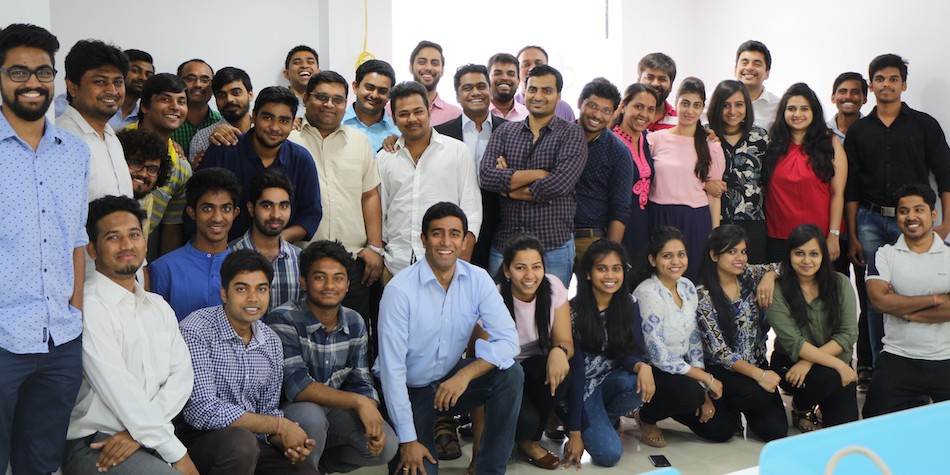
Photo credit: Pixabay.
(This article was co-authored with Prasanna Krishnamoorthy.)
This is part of a series of articles on the SaaS story blooming in India.
In the first part of the series, we took a case study to show the inherent advantages that an Indian SaaS startup typically has over its counterparts around the world.
In the second part, we derived insights from a Signal Hill-iSPIRT survey of SaaS startups to see how emerging players in this space can make the most of those Indian advantages. Today, in the third part, we look at new trends and opportunities that India’s new wave of SaaS startups can capitalize on. But first, let’s look at the genesis of what’s happening today.
Flashback to 1990. India as a whole had about 200 IT companies clocking US$100 million in revenue collectively. If someone had dared to bet that a single company would hit US$1 billion revenue 14 years later, they would have been laughed out of the room.
To grow beyond US$10 million, an IT company needed to start making bigger deals with Fortune 500 companies. Deals ranging from US$10 million to 50 million, to even 100 million.
Back in the early nineties, it looked like you needed magic to land those deals, or relationships spanning years. Perhaps only the likes of IBM or EDS had the magic and the rolodex to land those kinds of contracts. How would upstarts from India even service such large projects, when the customer was in the US and the IT company in Bangalore?
The Indian IT industry grew 120-fold in 14 years to hit US$12 billion by 2004.
Fast-forward a few years to 1998 and the emergence of the Y2K scare, anticipating the humongous problems computers and software would run into with dates beyond ’99 in the new millennium. Suddenly, suit-clad Indian IT sales folks were winning big deals to fix this bug in software and data – not yet at the US$100 million milestone but Indian IT was on a roll to get there.
By 2004, landing a multi-year US$100 million contract was a done deal with the newfound respect Indian IT had earned. And TCS was the first to reach an annual revenue of US$1 billion. The Indian IT industry as a whole was at US$12 billion – a 120-fold rise in 14 years.
How was the magic captured? How were those projects delivered remotely? How was quality assured? How were the tens of thousands of developers hired and trained and deployed?
A few good skills
As Indian IT companies found out, it wasn’t really magic. There were a few key skills that Indian businessmen needed to learn to win these large contracts, and get to a US$1 billion revenue. And if there’s one thing that Hyderabad and Kota have proved, it’s that India is really, really good at replicating skills at scale.
The best people who learned these skills hopped across IT companies, bringing their learnings with them. Industry body NASSCOM helped form a community of professionals who learned from each other. And boom, a skill that was so rare it seemed like magic, was suddenly in the hands of a thousand more people.
The IT war was won purely on cost arbitrage, and we see the end stages of that battle playing out.
We are now in the early stages of Indian SaaS, and it feels like deja vu. Getting to product-market fit and building a scalable, sustainable growth engine seems to be magical. A handful of people in India have gotten past product-market fit more than once. Zoho founder Sridhar Vembu and the Zoho mafia are the leading exponents. Girish Mathrubootham of Freshworks (earlier called Freshdesk) not only reached product-market fit, but also hit a US$100 million run-rate in Zoho, and is now doing it again at Freshworks. He has a line of new products, all of which are reaching customers and growing faster than their predecessors.
As the magic becomes skill, and the skill becomes transferable, the next 10 years could see an incredible growth of Indian SaaS startups, breaking through markets previously won only by US companies, and doing it at a scale and velocity that may seem preposterous now.
See: The unfair advantage Indian SaaS startups have over rivals around the world
Tail of the cost arbitrage battle
While the IT war was won purely on cost arbitrage, and we see the end stages of that battle playing out, SaaS as a product business offers a few different advantages, not limited to cost. And new ways to convert the cost arbitrage into a value arbitrage.
In SaaS, the two dominant costs are marketing and sales, followed by research and development (R&D). In each of these areas, studies have shown that people take up 80 percent of the whole cost. India with its large pool of IT talent, has a 1:3 advantage on R&D, and a whopping 1:5 advantage on marketing and sales.
In terms of customer acquisition cost (CAC), if a US company spends a dollar in CAC to get US$10 in lifetime value (LTV), an Indian company can spend US$0.30 CAC to get US$10 LTV. Or to put it another way, if a US company has a CAC payback period of a year, ‘rotating’ each dollar every year, an Indian company has a CAC payback period of 4 months, ‘rotating’ each dollar three times as fast. CAC turns will be a critical advantage in a SaaS battle.
On the other side of the sale, getting customers to integrate, train, configure, and get all their employees to use the workflows that the new tool provides typically requires people. This team is called ‘customer success.’
On the mid-market side, where contracts run between US$10,000 to US$30,000 a year, a US company would be hard-pressed to deploy enough people to make it work. On the other hand, an Indian SaaS company could deliver a very high-quality customer success team, that does everything it takes to deliver end-to-end customer value. On the small business side, there’s no budget at a US$1,000 ACV (all-commodity value) for a US company to have a customer success team, but an Indian company can. This leads to happier customers, with deeper integrations.
See: SaaS founders share 5 steps to success
15 years to create a new $2b market
There are also brand new opportunities that match the advantages enjoyed by Indian SaaS.
Take, for illustration, a company that has built a niche SaaS product for a micro-market. The total addressable market is worth US$15 million to US$25 million. Of this, the company has captured US$6 million. This market is very hard for a US company to make a profit out of.
There is a host of new markets for SaaS that historically have not been served by software made for them. The size of these markets is hard to guess, and evolves over time.
Case in point, the document e-signature market. If you had asked for the size of the e-signing market in 2007, you would have received bewildered looks. By 2015, the market was as big as US$500 million, with two companies at over US$100 million revenue. And by 2021, it’s expected to hit US$2.1 billion – 15 years to create a new market worth US$2 billion.
Now imagine a marketing tool for life insurance companies. An innovation management solution for the automobile industry. A customer management tool for dry cleaners. Each of these SaaS products may today be in a market that seems barely there. But there are real serious founders, who have domain expertise in each area, building SaaS products for each of them.

The Darwinbox team. Photo credit: Darwinbox.
This brings us to the critical ingredient for successful business-facing SaaS startups: domain expertise. Over the last 30-odd years, Indian and multinational businesses have created a significant pool of domain experts, whether in a McKinsey consulting role, or a vertical practice at IT bellwether Wipro. These insiders now have a deep understanding of a specific domain, appreciate and empathize with businesses in it, may have identified one or more key challenges, and have a network of prospective customers ready to believe.
Take HR software-maker Darwinbox, for example. Its founders, Rohit Chennamaneni, Chaitanya Peddi, and Jayant Paleti, held client-facing roles at Mckinsey & Company, Google, Ernst & Young, and Deloitte before starting Darwinbox. “So we had access to large companies, understood their needs, and knew what problems they were facing,” Chennamaneni says.
The three founders leveraged their consultancy background to do all the selling in the first year. Their 40 initial clients all came through referrals.
See: HR startup ropes in 40 big enterprise clients within a year. Founder explains how.
When these domain experts become entrepreneurs, they typically bring along friends and colleagues with product development and sales/marketing expertise. While this expertise may not have been gained at a startup, in many cases the founders and team are able to transition into a startup culture and grow their products and businesses using their deep specific knowledge.
The human touch
Another category of SaaS companies which would do well out of India are those with a human element to their product cycle. Take Chennai-based Unmetric, for example. It tracks the social media presence of brands and helps them do comparative benchmarking. While the data is collected by machines, there are limits to the tech gathering and classifying information like social media messages. “Sometimes you need human intelligence on top of it for things that can’t be exactly categorized. So Unmetric has a team in Chennai that does that,” says Alok Goyal, co-founder of Stellaris Venture Partners.

The Unmetric team at one of their weekly “unwind” sessions. Photo credit: Unmetric.
Business analytics provider Manthan is another example. While it has a strong software product in retail analytics, there’s an implementation angle to it which involves human work. “You have a distinct India advantage where there is some level of human involvement. Early in the cycle, that makes a lot of difference to the startups,” Alok notes.
The first wave of SaaS companies in India were building business applications – from human resources management to customer support. Zoho with its tool suite for businesses, Freshdesk in customer support, Kissflow in workflow automation, ChargeBee in billing … are all examples. Then came vertical-oriented SaaS products. For example, RateGain in the travel sector, Zenoti offering software products to wellness centers, and Vymo for financial enterprises.
“Gradually, we will see deeper tech come out of India as well because the supply of talent is only going up. It could be security-oriented software, infrastructure software, and so on,” says Goyal. A good example is Qubole. It allows data scientists to quickly take stored data, set it up in a cloud, and start analyzing it.
We will continue this series of articles on SaaS in the coming weeks with insights from more startup founders and investors. If there is anything in particular that you are curious about and would like us to focus on, please let us know in the comments below.
(Thank you Samidha Agarwal (St. Xavier’s College, Jaipur) and Naman Narain (Kalaari Capital) for helping with data for this article.)
This post New trends in SaaS, and how Indian startups are grabbing those opportunities appeared first on Tech in Asia.
from Tech in Asia https://www.techinasia.com/saas-startups-grabbing-new-opportunities
via IFTTT
No comments:
Post a Comment